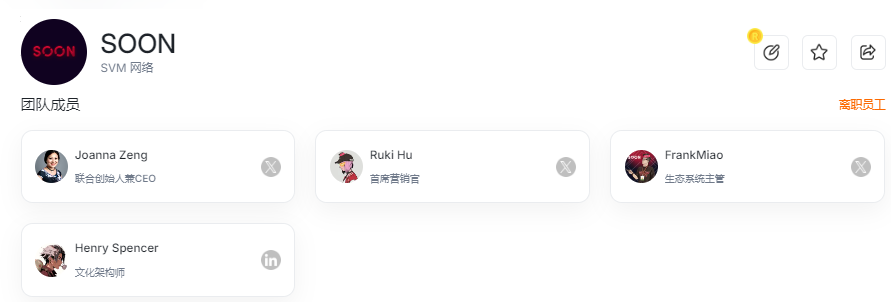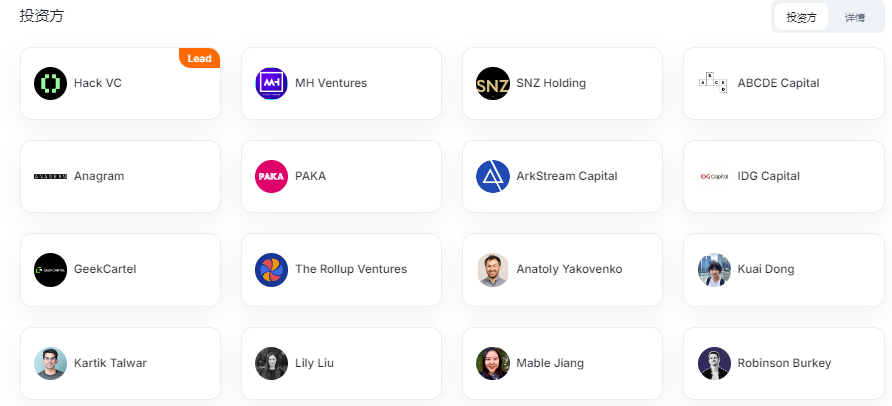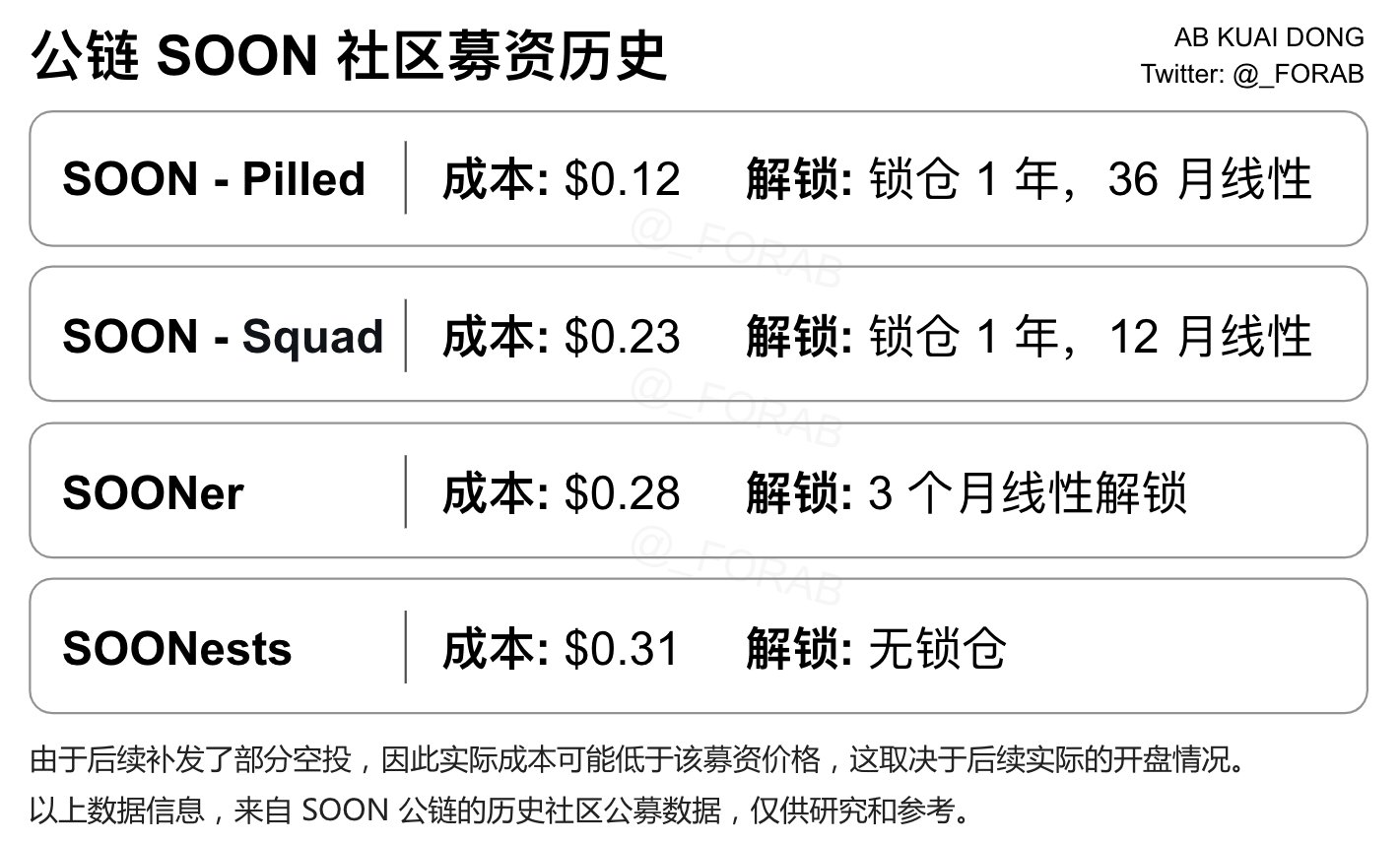Author: Lawrence
On May 19, 2025, Binance Alpha officially announced that it will launch the SOON token ($SOON) on May 23, becoming the first trading platform to integrate the project. This move not only marks a key breakthrough in the Solana Virtual Machine (SVM) ecosystem in the Layer2 track, but also means that modular blockchain technology has entered a new stage of large-scale application. As a star project with a financing amount of over US$22 million in 2025, SOON attempts to solve the performance bottlenecks and cross-chain interoperability problems of public chains such as Ethereum with its "decoupled SVM+OP Stack+configurable DA layer" architecture design. The community-led distribution mechanism and potential value capture capabilities in its token economics have attracted great attention from the market.
1. Team background: From Aleo to SVM infrastructure, gathering top industry resources

SOON's core team can be called an "all-star lineup" in the blockchain field.
CEO Joanna Zeng was formerly the vice president of the privacy public chain Aleo, and led the commercialization of zero-knowledge proof technology. She also accumulated a wealth of Layer2 development experience at institutions such as Coinbase and OP Labs.
Chief Marketing Officer Ruki Hu was born in JDI Global, a top investment bank in Hong Kong. He has led investments in SVM ecosystem projects such as Sonic SVM. His strategic management background at Peking University HSBC Business School provides methodological support for SOON's market expansion.
The technical director Andrew Z is a Rust language expert who has participated in the development of the Solana core client and has extensive experience in optimizing the SVM architecture.
It is worth noting that SOON's advisory team includes heavyweights such as Solana co-founder Anatoly Yakovenko and Celestia core developer Mustafa Al-Bassam. This triple resource integration of "technology + capital + ecology" has enabled it to quickly stand out in the fiercely competitive Rollup track.
2. Financing History: Innovation of Community Fundraising Paradigm, Build a Moat with US$22 Million

Image credit: @_FORAB
SOON's financing path breaks the traditional venture capital-dominated model and creates an innovative fundraising mechanism of "NFT sales + community co-construction".
In January 2025, the project raised $22 million through tiered NFT sales, of which 51% of the tokens were fairly distributed through three types of NFTs: the $900 tier provided short-term liquidity with a linear unlocking period of 3 months, the $2,850 tier was designed with a 12-month lock-up period to screen long-term holders, and the $22,500 high threshold tier was locked for 36 months to attract strategic investors to deeply participate in ecological construction. This design not only avoids the impact of VC shares on the selling pressure of the secondary market, but also distinguishes user risk preferences through the time dimension.

The lineup of investors also reflects the industry's recognition - top institutions such as Hack VC and ABCDE Capital led the investment, and strategic parties such as Solana Ecosystem Fund and Celestia Labs supported it. Even traditional capital IDG and PAKA also made rare investments. The funds are mainly invested in three directions: 40% is used for the research and development of the main network and cross-chain protocols, 30% is invested in the developer ecosystem incentive plan, and the remaining 30% is reserved for responding to market fluctuations and security audits.
3. Technical Architecture: Decoupling SVM to Reconstruct Performance Boundaries and Modular Design to Define Industry Standards
SOON's technological innovation revolves around three core components:
1. SOON Mainnet: Ethereum’s first SVM Rollup execution layer
By decoupling the Solana Virtual Machine (SVM) from native consensus, the SOON mainnet achieves a 50 millisecond block time and a throughput of 30,000 TPS on Ethereum, which is more than 5 times higher than OP Rollup such as Optimism. Its key technological breakthroughs are:
- Merklization optimization: Use Merkle root compression state to verify data, which increases the efficiency of cross-chain transaction verification by 80%;
- Horizontal expansion architecture: Distributed nodes process transactions in parallel, combined with data availability solutions such as EigenDA, it can be elastically expanded to 650,000 TPS;
- Native cross-chain settlement: Using Ethereum as the final settlement layer, while being compatible with modular DA solutions such as Celestia and Avail, reducing the Gas cost to 1/10 of Arbitrum.
2. SOON Stack: Multi-chain Rollup Deployment Framework
Developers can use SOON Stack to deploy customized SVM Layer2 on public chains such as BNB Chain and Ton with one click. Testnet data shows that the svmBNB chain built on this framework has achieved 15,000 TPS and supports high-performance scenarios such as AI proxy transactions and real-time game engines. This "Lego-style" architecture makes SOON the first universal Rollup solution that spans the EVM and non-EVM ecosystems.
3. InterSOON Protocol: Intermediary-free cross-chain communication layer
Based on Hyperlane's improved messaging protocol, assets and smart contracts are allowed to interact directly between multiple chains, eliminating the custody risk of cross-chain bridges. In the test case of Solana and Ethereum, the time required for USDC cross-chain transfer was shortened from an average of 8 minutes to 22 seconds, and the handling fee was reduced by 95%.
SOON Token Investment Value Assessment: Unlocking the Dual Risks of Selling Pressure and Valuation Bubble
Although SOON has attracted market attention with its innovative technical architecture and community-based token distribution mechanism, its investment risk is significantly amplified under the dual pressure of token unlocking cycle and imbalanced valuation model. The following analyzes its potential risks from the dimensions of structural defects in token economics, imbalance in market supply and demand, and comparison with similar projects.
1. The token unlocking mechanism hides the risk of large-scale selling pressure
According to the token distribution plan announced by SOON, 51% of the tokens are distributed through the community (including NFT pre-sales), while the team and co-builders hold 10% of the shares, and the foundation and ecological incentives account for 31%. Although the project emphasizes the "linear unlocking" design, the actual unlocking rhythm may still trigger a market sell-off:
Short-term arbitrage motivation of NFT holders: Among the 510 million tokens allocated by the community, 3,200 tokens corresponding to the first tier (900 USD NFT) are locked for only 3 months. The cost of such investors is concentrated in the range of 0.28-0.31 USD. If the price exceeds 0.5 USD in the initial listing, the profit-taking pressure will be quickly released68. Historical data shows that the proportion of retail investors selling within 30 days after unlocking is as high as 65%-80%, which may cause the circulation to surge by more than 50%.
Delayed impact of unlocking by the team and institutions: Although the 100 million tokens held by the team are set to lock up for 12 months, based on the experience of similar projects, the average reduction ratio of core members after the lock-up period is more than 40%. According to the current FDV (fully diluted valuation), the potential selling pressure is as high as US$400 million35. In addition, the over-the-counter shares held by strategic investors (such as Hack VC and ABCDE Capital) may be transferred in advance through the OTC market, indirectly increasing the secondary market supply.
Risk of token dumping for ecological incentives: The ecological development fund (250 million tokens), which accounts for 25% of the total, adopts a "release on demand" mechanism, but the project party often over-issues rewards to attract developers. Referring to the operating data of projects such as Optimism, the actual circulation speed of ecological incentive tokens is 2-3 times faster than planned, and an additional 50 million tokens may be released each year.
2. Valuation bubble: FDV/TVL ratio deviates seriously from the industry benchmark
Based on the fully diluted valuation (FDV) analysis before the launch of SOON's mainnet, if the preset total amount of 1 billion tokens is calculated based on the lowest NFT pre-sale valuation (FDV of $90 million), the FDV/TVL (total locked value) ratio is as high as 18.7 (assuming TVL is $5 million), far exceeding mature Layer2 projects such as Optimism (2.3) and Arbitrum (1.8). Even compared with Sonic SVM (FDV of $220 million and TVL of $110 million), which is also an SVM ecosystem, SOON's valuation still has a significant premium, but the technological differentiation has not yet formed a moat.
What is more alarming is that market sentiment has already overdrawn technical expectations in advance. Although the SOON mainnet TPS (30,000) is higher than the mainstream Rollup, the Celestia DA layer it relies on has not undergone large-scale stress testing, and the actual performance may be discounted by 30%-50%. Once a downtime or security incident occurs after the mainnet is launched, the support logic of FDV will quickly collapse.
3. Deterioration of the competitive landscape: Shortening of the window period for technological first-mover advantage
SOON's core narrative - decoupling SVM and modular architecture - is facing direct impact from projects such as Eclipse and Movement. Eclipse has received $50 million in financing led by Polychain Capital and announced the deployment of a general Rollup based on SVM on Solana, which has better developer tool compatibility and ecological resource integration capabilities than SOON. In addition, the cost advantage of Celestia's native DA layer (60% lower than SOON) further weakens the persuasiveness of its modular story.
Judging from the market share, the SOON testnet only attracted more than 80 DApp migrations, while the number of developers of Arbitrum and zkSync exceeded 3,000 during the same period. The lag in the cold start of the ecosystem may cause it to become a "technical laboratory" rather than an actual application layer.
IV. Investment advice: Risk avoidance in high volatility cycles
In summary, SOON tokens will enter a period of concentrated risk release from May to August 2025:
- Short term (1-3 months): The liquidity premium in the early stage of Binance Alpha’s launch may push the price up to US$0.4-0.5, but when the first round of NFT unlocking (August) approaches, market panic will trigger a pullback, and the support level will be down to US$0.22.
- Medium term (6-12 months): The unlocking of team and institutional tokens (Q1 2026) may lead to secondary selling pressure. If TVL does not exceed US$200 million during the same period, the FDV/TVL ratio will return to the industry average, and the token price may be halved to the range of US$0.1-0.15.
- Long term (more than 1 year): Competition in the modular track is fierce. If SOON fails to achieve a breakthrough in cross-chain interoperability, the token may become a "governance tool" and lose its value capture ability.
For investors with low risk appetite, it is recommended to wait and see the on-chain data (TVL, cross-chain asset size, developer activity) three months after the mainnet launch, and choose the opportunity to deploy after the technology is verified and the supply and demand of tokens are rebalanced.
Conclusion: Valuation trap under the innovation narrative
Although SOON's modular vision is in line with the industry's evolution trend, its token model design and market competition pattern have not yet formed a safety margin. When the halo of technology fades, the resonance of unlocking selling pressure and valuation bubbles may trigger a Davis double kill. At a time when the Layer2 war has entered the decisive stage of "application landing", investors should pay more attention to the real value creation of the ecosystem rather than the involutionary game of technical parameters.





